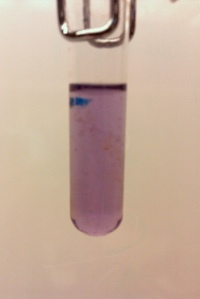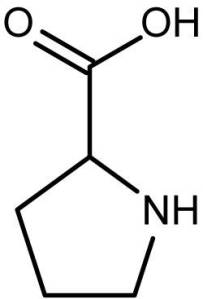The Ninhydrin Test is used to test for the presence of amino acids (NOT proteins).
Ninhydrin degrades amino acids into aldehydes, ammonia, and CO2 (carbon dioxide) through a series of reactions; the net result is ninhydrin in a partially reduced form hydrindantin:
 (reaction 1)
(reaction 1)
Ninhydrin then condenses with ammonia and hydrindantin to produce a blueish-purple pigment.
The typical positive result is a blueish-purple color, as seen in the image below:
(Image credit: pdecell)
But, there is an amino acid that gives a yellow result. This amino acid is PROLINE.
(Image Credit)
As you can see, proline has a ring structure (secondary amino acid).
The blueish-purple result is usually associated with primary amino acids. In these amino acids, the N is free to react with ninhydrin. However, in proline, the N is not available for reaction as it is locked in the ring structure. Therefore no ammonia is produced, so no blue color is presented (see “reaction 2” above).
(Click here for reference and more on the Ninhydrin Test)



thanks! this was a really great simple explination 😀
Thanks. I always try to make it as simple as possible so I could remember.
Reblogged this on BioChemology and commented:
Really informative & simple explanation 🙂
Pingback: Why yellow? | biochemeek
Pingback: The Powerful Proteins!!! | Biochemistry3rst
thank you 🙂
This was great help!
Glad this is still helping people ^-^
Thank you, hugely helpful.
Thank you for this! At least if I get this question on my exam I’ll be able to answer it. 😀